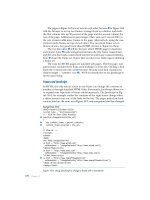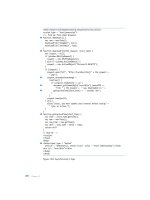Mastering elasticsearch 2nd
Bạn đang xem bản rút gọn của tài liệu. Xem và tải ngay bản đầy đủ của tài liệu tại đây (4.95 MB, 434 trang )
Mastering Elasticsearch
Second Edition
Further your knowledge of the Elasticsearch server
by learning more about its internals, querying, and
data handling
Rafał Kuć
Marek Rogoziński
BIRMINGHAM - MUMBAI
Mastering Elasticsearch
Second Edition
Copyright © 2015 Packt Publishing
All rights reserved. No part of this book may be reproduced, stored in a retrieval
system, or transmitted in any form or by any means, without the prior written
permission of the publisher, except in the case of brief quotations embedded in
critical articles or reviews.
Every effort has been made in the preparation of this book to ensure the accuracy
of the information presented. However, the information contained in this book is
sold without warranty, either express or implied. Neither the authors, nor Packt
Publishing, and its dealers and distributors will be held liable for any damages
caused or alleged to be caused directly or indirectly by this book.
Packt Publishing has endeavored to provide trademark information about all of the
companies and products mentioned in this book by the appropriate use of capitals.
However, Packt Publishing cannot guarantee the accuracy of this information.
First published: October 2013
Second edition: February 2015
Production reference: 1230215
Published by Packt Publishing Ltd.
Livery Place
35 Livery Street
Birmingham B3 2PB, UK.
ISBN 978-1-78355-379-2
www.packtpub.com
Credits
Authors
Copy Editors
Rafał Kuć
Stuti Srivastava
Marek Rogoziński
Sameen Siddiqui
Reviewers
Hüseyin Akdoğan
Project Coordinator
Akash Poojary
Julien Duponchelle
Marcelo Ochoa
Commissioning Editor
Proofreaders
Paul Hindle
Joanna McMahon
Akram Hussain
Indexer
Acquisition Editor
Hemangini Bari
Rebecca Youé
Content Development Editors
Madhuja Chaudhari
Anand Singh
Technical Editors
Saurabh Malhotra
Narsimha Pai
Graphics
Sheetal Aute
Valentina D'silva
Production Coordinator
Alwin Roy
Cover Work
Alwin Roy
About the Author
Rafał Kuć is a born team leader and software developer. Currently, he is
working as a consultant and a software engineer at Sematext Group, Inc., where
he concentrates on open source technologies, such as Apache Lucene, Solr,
Elasticsearch, and the Hadoop stack. He has more than 13 years of experience in
various software branches—from banking software to e-commerce products. He
is mainly focused on Java but is open to every tool and programming language
that will make the achievement of his goal easier and faster. Rafał is also one of
the founders of the solr.pl website, where he tries to share his knowledge and
help people with their problems related to Solr and Lucene. He is also a speaker at
various conferences around the world, such as Lucene Eurocon, Berlin Buzzwords,
ApacheCon, Lucene Revolution, and DevOps Days.
He began his journey with Lucene in 2002, but it wasn't love at first sight. When
he came back to Lucene in late 2003, he revised his thoughts about the framework
and saw the potential in search technologies. Then came Solr, and that was it. He
started working with Elasticsearch in the middle of 2010. Currently, Lucene, Solr,
Elasticsearch, and information retrieval are his main points of interest.
Rafał is the author of Solr 3.1 Cookbook, its update—Solr 4.0 Cookbook—and its third
release—Solr Cookbook, Third Edition. He is also the author of Elasticsearch Server and
its second edition, along with the first edition of Mastering Elasticsearch, all published
by Packt Publishing.
Acknowledgments
With Marek, we were thinking about writing an update to Mastering Elasticsearch,
Packt Publishing. It was not a book for everyone, but the first version didn't put
enough emphasis on that—we were treating Mastering Elasticsearch as an update to
Elasticsearch Server. The same goes with Mastering Elasticsearch Second Edition. The
book you are holding in your hands was written as an extension to Elasticsearch
Server Second Edition, Packt Publishing, and should be treated as a continuation to that
book. Because of such an approach, we could concentrate on topics such as choosing
the right queries, scaling Elasticsearch, extensive scoring descriptions with examples,
internals of filtering, new aggregations, comparison to documents' relations
handling, and so on. Hopefully, after reading this book, you'll be able to easily get all
the details about Elasticsearch and the underlying Apache Lucene architecture; this
will let you get the desired knowledge easier and faster.
I would like to thank my family for the support and patience during all those days
and evenings when I was sitting in front of a screen instead of being with them.
I would also like to thank all the people I'm working with at Sematext, especially
Otis, who took his time and convinced me that Sematext is the right company for me.
Finally, I would like to thank all the people involved in creating, developing, and
maintaining Elasticsearch and Lucene projects for their work and passion. Without
them, this book wouldn't have been written and open source search wouldn't have
been the same as it is today.
Once again, thank you.
About the Author
Marek Rogoziński is a software architect and consultant with over 10 years of
experience. He specializes in solutions based on open source search engines, such as
Solr and Elasticsearch, and software stack for Big Data analytics, including Hadoop,
Hbase, and Twitter Storm.
He is also a cofounder of the solr.pl website, which publishes information and
tutorials about Solr and Lucene libraries. He is the coauthor of Mastering ElasticSearch,
ElasticSearch Server, and Elasticsearch Server Second Edition, both published by
Packt Publishing.
Currently, he holds the position of chief technology officer and lead architect
at ZenCard, a company processing and analyzing large amounts of payment
transactions in real time, allowing automatic and anonymous identification of retail
customers on all retailer channels (m-commerce / e-commerce / brick and mortar)
and giving retailers a customer retention and loyalty tool.
Acknowledgments
This is our fourth book about Elasticsearch and, again, I am fascinated by how
quickly Elasticsearch is evolving. We always have to find the balance between
describing features marked as experimental or work in progress, and we have to
take the risk that the final code might behave differently or even ignore some of
the interesting features. The second edition of this book has quite a large number
of rewrites and covers some new features; however, this comes at the cost of the
removal of some information that was less useful for readers. With this book, we've
tried to introduce some additional topics connected to Elasticsearch. However, the
whole ecosystem and the ELK stack (Elasticsearch, Logstash, and Kibana) or Hadoop
integration deserves a dedicated book.
Now, it is time to say thank you.
Thanks to all the people who created Elasticsearch, Lucene, and all the libraries
and modules published around these projects or used by these projects.
I would also like to thank the team that worked on this book. First of all, thanks to
the ones who worked on the extermination of all my errors, typos, and ambiguities.
Many thanks to all the people who sent us remarks or wrote constructive reviews.
I was surprised and encouraged by the fact that someone found our work useful.
Thank you.
Last but not least, thanks to all the friends who stood by me and understood my
constant lack of time.
About the Reviewers
Hüseyin Akdoğan's software adventure began with the GwBasic programming
language. He started learning the Visual Basic language after QuickBasic, and
developed many applications with it until 2000 when he stepped into the world of
Web with PHP. After that, his path crossed with Java! In addition to counseling and
training activities since 2005, he developed enterprise applications with Java EE
technologies. His areas of expertise are JavaServer Faces, Spring frameworks, and
Big Data technologies such as NoSQL and Elasticsearch. In addition, he is trying to
specialize in other Big Data technologies.
Julien Duponchelle is a French engineer. He is a graduate of Epitech. During his
professional career, he contributed to several open source projects and focused on
tools that make the work of IT teams easier.
After he led the educational field at ETNA, a French IT school, Julien accompanied
several start-ups as a lead backend engineer and participated in many significant
and successful fundraising events (Plizy and Youboox).
I want to thank Maëlig, my girlfriend, for her benevolence and great
patience during so many evenings when I was working on this book
or on open source projects in general.
Marcelo Ochoa works at the system laboratory of Facultad de Ciencias Exactas of
the Universidad Nacional del Centro de la Provincia de Buenos Aires and is the CTO
at Scotas.com, a company that specializes in near real-time search solutions using
Apache Solr and Oracle. He divides his time between university jobs and external
projects related to Oracle and big data technologies. He has worked on several
Oracle-related projects, such as the translation of Oracle manuals and multimedia
CBTs. His background is in database, network, web, and Java technologies. In the
XML world, he is known as the developer of the DB Generator for the Apache
Cocoon project. He has worked on the open source projects DBPrism and DBPrism
CMS, the Lucene-Oracle integration using the Oracle JVM Directory implementation,
and the Restlet.org project, where he worked on the Oracle XDB Restlet Adapter,
which is an alternative to writing native REST web services inside a database
resident JVM.
Since 2006, he has been part of an Oracle ACE program. Oracle ACEs are known
for their strong credentials as Oracle community enthusiasts and advocates,
with candidates nominated by ACEs in the Oracle technology and applications
communities.
He has coauthored Oracle Database Programming using Java and Web Services by
Digital Press and Professional XML Databases by Wrox Press, and has been the
technical reviewer for several PacktPub books, such as "Apache Solr 4 Cookbook",
"ElasticSearch Server", and others.
www.PacktPub.com
Support files, eBooks, discount offers, and more
For support files and downloads related to your book, please visit www.PacktPub.com.
Did you know that Packt offers eBook versions of every book published, with PDF
and ePub files available? You can upgrade to the eBook version at www.PacktPub.
com and as a print book customer, you are entitled to a discount on the eBook copy.
Get in touch with us at for more details.
At www.PacktPub.com, you can also read a collection of free technical articles, sign
up for a range of free newsletters and receive exclusive discounts and offers on Packt
books and eBooks.
TM
/>
Do you need instant solutions to your IT questions? PacktLib is Packt's online digital
book library. Here, you can search, access, and read Packt's entire library of books.
Why subscribe?
• Fully searchable across every book published by Packt
• Copy and paste, print, and bookmark content
• On demand and accessible via a web browser
Free access for Packt account holders
If you have an account with Packt at www.PacktPub.com, you can use this to access
PacktLib today and view 9 entirely free books. Simply use your login credentials for
immediate access.
Table of Contents
Preface
Chapter 1: Introduction to Elasticsearch
Introducing Apache Lucene
Getting familiar with Lucene
Overall architecture
Getting deeper into Lucene index
1
7
8
8
8
10
Analyzing your data
11
Lucene query language
12
Introducing Elasticsearch
Basic concepts
15
16
Indexing and querying
Understanding the basics
Querying fields
Term modifiers
Handling special characters
12
12
13
14
15
Index16
Document16
Type16
Mapping16
Node17
Cluster17
Shard17
Replica18
Key concepts behind Elasticsearch architecture
Workings of Elasticsearch
18
19
Communicating with Elasticsearch
21
The startup process
Failure detection
Indexing data
Querying data
The story
Summary
19
20
22
23
24
26
Table of Contents
Chapter 2: Power User Query DSL
27
Lucene conceptual scoring formula
Lucene practical scoring formula
29
29
Default Apache Lucene scoring explained
When a document is matched
TF/IDF scoring formula
27
28
29
Elasticsearch point of view
An example
Query rewrite explained
Prefix query as an example
Getting back to Apache Lucene
Query rewrite properties
Query templates
Introducing query templates
30
31
34
35
37
39
42
42
The Mustache template engine
45
Templates as strings
45
Conditional expressions
Loops
Default values
46
46
47
Storing templates in files
Handling filters and why it matters
Filters and query relevance
How filters work
48
49
49
53
Performance considerations
Post filtering and filtered query
Choosing the right filtering method
Choosing the right query for the job
Query categorization
55
56
58
59
59
Bool or and/or/not filters
Basic queries
Compound queries
Not analyzed queries
Full text search queries
Pattern queries
Similarity supporting queries
Score altering queries
Position aware queries
Structure aware queries
The use cases
55
60
61
62
62
63
63
63
64
64
64
Example data
Basic queries use cases
Compound queries use cases
Not analyzed queries use cases
Full text search queries use cases
65
66
67
71
73
[ ii ]
Table of Contents
Pattern queries use cases
Similarity supporting queries use cases
Score altering queries use cases
Pattern queries use cases
Structure aware queries use cases
74
75
77
79
81
Summary
Chapter 3: Not Only Full Text Search
Query rescoring
What is query rescoring?
An example query
Structure of the rescore query
Rescore parameters
Choosing the scoring mode
83
85
85
86
86
86
89
90
To sum up
Controlling multimatching
Multimatch types
90
91
92
Best fields matching
Cross fields matching
Most fields matching
Phrase matching
Phrase with prefixes matching
92
95
97
98
99
Significant terms aggregation
An example
Choosing significant terms
Multiple values analysis
Significant terms aggregation and full text search fields
100
100
103
104
106
Additional configuration options
107
There are limits
113
Controlling the number of returned buckets
Background set filtering
Minimum document count
Execution hint
More options
Memory consumption
Shouldn't be used as top-level aggregation
Counts are approximated
Floating point fields are not allowed
107
108
109
112
112
113
113
113
113
Documents grouping
Top hits aggregation
An example
114
114
115
Relations between documents
The object type
The nested documents
120
121
125
Additional parameters
118
[ iii ]
Table of Contents
Parent–child relationship
126
Parent–child relationship in the cluster
A few words about alternatives
Scripting changes between Elasticsearch versions
Scripting changes
Security issues
Groovy – the new default scripting language
Removal of MVEL language
127
129
130
130
130
130
131
Short Groovy introduction
131
Scripting in full text context
137
Lucene expressions explained
146
Using Groovy as your scripting language
Variable definition in scripts
Conditionals
Loops
An example
There is more
Field related information
Shard level information
Term-level information
131
132
132
133
134
137
137
140
141
The basics
An example
There is more
146
146
149
Summary
Chapter 4: Improving the User Search Experience
Correcting user spelling mistakes
Testing data
Getting into technical details
Suggesters
Using the _suggest REST endpoint
Understanding the REST endpoint suggester response
Including suggestion requests in query
The term suggester
The phrase suggester
The completion suggester
149
151
152
152
153
154
154
155
157
160
163
175
Improving the query relevance
181
Data181
The quest for relevance improvement
185
The standard query
The multi match query
Phrases comes into play
Let's throw the garbage away
Now, we boost
Performing a misspelling-proof search
Drill downs with faceting
185
186
187
190
193
194
196
Summary
200
[ iv ]
Table of Contents
Chapter 5: The Index Distribution Architecture
203
Choosing the right amount of shards and replicas
204
Sharding and overallocation
204
A positive example of overallocation
206
206
Multiple shards versus multiple indices
Replicas206
207
Routing explained
Shards and data
207
Let's test routing
208
Indexing with routing
211
Routing in practice
212
Querying
214
Aliases216
Multiple routing values
217
Altering the default shard allocation behavior
218
Allocation awareness
219
Forcing allocation awareness
221
Filtering221
What include, exclude, and require mean
222
Runtime allocation updating
222
Defining total shards allowed per node
Defining total shards allowed per physical server
224
224
Index level updates
Cluster level updates
223
223
Inclusion
224
Requirement226
Exclusion227
Disk-based allocation
227
Query execution preference
Introducing the preference parameter
Summary
Chapter 6: Low-level Index Control
Altering Apache Lucene scoring
Available similarity models
Setting a per-field similarity
Similarity model configuration
Choosing the default similarity model
Configuring the chosen similarity model
Choosing the right directory implementation – the store module
The store type
The simple filesystem store
The new I/O filesystem store
The MMap filesystem store
[v]
228
229
231
233
233
234
235
236
237
238
240
240
240
241
241
Table of Contents
The hybrid filesystem store
The memory store
The default store type
The default store type for Elasticsearch 1.3.0 and higher
The default store type for Elasticsearch versions older than 1.3.0
NRT, flush, refresh, and transaction log
Updating the index and committing changes
Changing the default refresh time
The transaction log
242
242
243
243
243
244
245
246
246
The transaction log configuration
247
Near real-time GET
Segment merging under control
Choosing the right merge policy
248
249
250
Merge policies' configuration
252
Scheduling
254
The tiered merge policy
The log byte size merge policy
The log doc merge policy
251
251
251
The tiered merge policy
The log byte size merge policy
The log doc merge policy
252
253
254
The concurrent merge scheduler
The serial merge scheduler
Setting the desired merge scheduler
255
255
255
When it is too much for I/O – throttling explained
Controlling I/O throttling
Configuration
256
256
256
Understanding Elasticsearch caching
The filter cache
259
259
The throttling type
Maximum throughput per second
Node throttling defaults
Performance considerations
The configuration example
Filter cache types
Node-level filter cache configuration
Index-level filter cache configuration
The field data cache
Field data or doc values
Node-level field data cache configuration
Index-level field data cache configuration
The field data cache filtering
Field data formats
Field data loading
[ vi ]
257
257
257
257
258
260
260
261
262
262
263
263
264
269
270
Table of Contents
The shard query cache
271
Using circuit breakers
273
Clearing the caches
Index, indices, and all caches clearing
274
274
Setting up the shard query cache
272
The field data circuit breaker
The request circuit breaker
The total circuit breaker
Clearing specific caches
Summary
Chapter 7: Elasticsearch Administration
Discovery and recovery modules
Discovery configuration
Zen discovery
273
273
273
274
275
277
277
278
278
Master node
280
The gateway and recovery configuration
286
Configuring master and data nodes
The master election configuration
The Amazon EC2 discovery
Other discovery implementations
The gateway recovery process
Configuration properties
Expectations on nodes
The local gateway
Low-level recovery configuration
The indices recovery API
The human-friendly status API – using the Cat API
The basics
Using the Cat API
Common arguments
The examples
Getting information about the master node
Getting information about the nodes
280
281
283
286
287
287
288
289
290
292
295
296
298
298
299
299
300
Backing up
Saving backups in the cloud
300
301
Federated search
The test clusters
Creating the tribe node
305
305
306
The S3 repository
The HDFS repository
The Azure repository
301
302
304
Using the unicast discovery for tribes
306
Reading data with the tribe node
307
Master-level read operations
308
[ vii ]
Table of Contents
Writing data with the tribe node
309
Master-level write operations
309
Handling indices conflicts
Blocking write operations
Summary
Chapter 8: Improving Performance
Using doc values to optimize your queries
The problem with field data cache
The example of doc values usage
Knowing about garbage collector
Java memory
The life cycle of Java objects and garbage collections
Dealing with garbage collection problems
Turning on logging of garbage collection work
Using JStat
Creating memory dumps
More information on the garbage collector work
Adjusting the garbage collector work in Elasticsearch
Avoid swapping on Unix-like systems
Benchmarking queries
Preparing your cluster configuration for benchmarking
Running benchmarks
Controlling currently run benchmarks
Very hot threads
Usage clarification for the Hot Threads API
The Hot Threads API response
Scaling Elasticsearch
Vertical scaling
Horizontal scaling
Automatically creating replicas
Redundancy and high availability
Cost and performance flexibility
Continuous upgrades
Multiple Elasticsearch instances on a single physical machine
Designated nodes' roles for larger clusters
Using Elasticsearch for high load scenarios
General Elasticsearch-tuning advices
Advices for high query rate scenarios
High indexing throughput scenarios and Elasticsearch
Summary
[ viii ]
310
311
312
313
314
314
315
318
319
320
321
322
323
326
326
326
328
329
329
330
335
336
337
338
339
339
340
342
343
345
345
345
347
349
350
355
361
367
Table of Contents
Chapter 9: Developing Elasticsearch Plugins
Creating the Apache Maven project structure
Understanding the basics
The structure of the Maven Java project
The idea of POM
Running the build process
Introducing the assembly Maven plugin
Creating custom REST action
The assumptions
Implementation details
Using the REST action class
The plugin class
Informing Elasticsearch about our REST action
Building the REST action plugin
Installing the REST action plugin
Checking whether the REST action plugin works
369
369
370
370
371
372
372
375
375
375
376
379
380
381
381
382
Creating the custom analysis plugin
Implementation details
383
383
Testing our custom analysis plugin
392
Implementing TokenFilter
Implementing the TokenFilter factory
Implementing the class custom analyzer
Implementing the analyzer provider
Implementing the analysis binder
Implementing the analyzer indices component
Implementing the analyzer module
Implementing the analyzer plugin
Informing Elasticsearch about our custom analyzer
Building our custom analysis plugin
Installing the custom analysis plugin
Checking whether our analysis plugin works
Summary
Index
384
385
386
387
388
389
390
391
392
392
393
393
394
397
[ ix ]
Preface
Welcome to the world of Elasticsearch and Mastering Elasticsearch Second Edition.
While reading the book, you'll be taken through different topics—all connected to
Elasticsearch. Please remember though that this book is not meant for beginners and
we really treat the book as a follow-up or second part of Elasticsearch Server Second
Edition. There is a lot of new content in the book and, sometimes, you can refer to the
content of Elasticsearch Server Second Edition within this book.
Throughout the book, we will discuss different topics related to Elasticsearch and
Lucene. We start with an introduction to the world of Lucene and Elasticsearch to
introduce you to the world of queries provided by Elasticsearch, where we discuss
different topics related to queries, such as filtering and which query to choose in a
particular situation. Of course, querying is not all and, because of that, the book you
are holding in your hands provides information on newly introduced aggregations
and features that will help you give meaning to the data you have indexed in
Elasticsearch indices, and provide a better search experience for your users.
Even though, for most users, querying and data analysis are the most interesting
parts of Elasticsearch, they are not all that we need to discuss. Because of this, the
book tries to bring you additional information when it comes to index architecture
such as choosing the right number of shards and replicas, adjusting the shard
allocation behavior, and so on. We will also get into the places where Elasticsearch
meets Lucene, and we will discuss topics such as different scoring algorithms,
choosing the right store mechanism, what the differences between them are, and
why choosing the proper one matters.
Last, but not least, we touch on the administration part of Elasticsearch by discussing
discovery and recovery modules, and the human-friendly Cat API, which allows us
to very quickly get relevant administrative information in a form that most humans
should be able to read without parsing JSON responses. We also talk about and use
tribe nodes, giving us possibilities of creating federated searches across many nodes.
Preface
Because of the title of the book, we couldn't omit performance-related topics, and
we decided to dedicate a whole chapter to it. We talk about doc values and the
improvements they bring, how garbage collector works, and what to do when it
does not work as we expect. Finally, we talk about Elasticsearch scaling and how to
prepare it for high indexing and querying use cases.
Just as with the first edition of the book, we decided to end the book with the
development of Elasticsearch plugins, showing you how to set up the Apache
Maven project and develop two types of plugins—custom REST action and
custom analysis.
If you think that you are interested in these topics after reading about them, we think
this is a book for you and, hopefully, you will like the book after reading the last
words of the summary in Chapter 9, Developing Elasticsearch Plugins.
What this book covers
Chapter 1, Introduction to Elasticsearch, guides you through how Apache Lucene works
and will reintroduce you to the world of Elasticsearch, describing the basic concepts
and showing you how Elasticsearch works internally.
Chapter 2, Power User Query DSL, describes how the Apache Lucene scoring works,
why Elasticsearch rewrites queries, what query templates are, and how we can use
them. In addition to that, it explains the usage of filters and which query should be
used in a particular use case.
Chapter 3, Not Only Full Text Search, describes queries rescoring, multimatching
control, and different types of aggregations that will help you with data analysis—
significant terms aggregation and top terms aggregation that allow us to group
documents with a certain criteria. In addition to that, it discusses relationship
handling in Elasticsearch and extends your knowledge about scripting in
Elasticsearch.
Chapter 4, Improving the User Search Experience, covers user search experience
improvements. It introduces you to the world of Suggesters, which allows you to
correct user query spelling mistakes and build efficient autocomplete mechanisms.
In addition to that, you'll see how to improve query relevance by using different
queries and the Elasticsearch functionality with a real-life example.
Chapter 5, The Index Distribution Architecture, covers techniques for choosing the right
amount of shards and replicas, how routing works, how shard allocation works,
and how to alter its behavior. In addition to that, we discuss what query execution
preference is and how it allows us to choose where the queries are going to
be executed.
[2]
Preface
Chapter 6, Low-level Index Control, describes how to alter the Apache Lucene scoring
and how to choose an alternative scoring algorithm. It also covers NRT searching
and indexing and transaction log usage, and allows you to understand segment
merging and tune it for your use case. At the end of the chapter, you will also find
information about Elasticsearch caching and request breakers aiming to prevent outof-memory situations.
Chapter 7, Elasticsearch Administration, describes what the discovery, gateway, and
recovery modules are, how to configure them, and why you should bother. We also
describe what the Cat API is, how to back up and restore your data to different cloud
services (such as Amazon AWS or Microsoft Azure), and how to use tribe nodes—
Elasticsearch federated search.
Chapter 8, Improving Performance, covers Elasticsearch performance-related topics
ranging from using doc values to help with field data cache memory usage through
the JVM garbage collector work, and queries benchmarking to scaling Elasticsearch
and preparing it for high indexing and querying scenarios.
Chapter 9, Developing Elasticsearch Plugins, covers Elasticsearch plugins' development
by showing and describing in depth how to write your own REST action and
language analysis plugin.
What you need for this book
This book was written using Elasticsearch server 1.4.x, and all the examples and
functions should work with it. In addition to that, you'll need a command that
allows you to send HTTP requests such as curl, which is available for most operating
systems. Please note that all examples in this book use the mentioned curl tool. If you
want to use another tool, please remember to format the request in an appropriate
way that is understood by the tool of your choice.
In addition to that, to run examples in Chapter 9, Developing Elasticsearch Plugins,
you will need a Java Development Kit (JDK) installed and an editor that will
allow you to develop your code (or Java IDE-like Eclipse). To build the code and
manage dependencies in Chapter 9, Developing Elasticsearch Plugins, we are using
Apache Maven.
[3]
Preface
Who this book is for
This book was written for Elasticsearch users and enthusiasts who are already
familiar with the basic concepts of this great search server and want to extend their
knowledge when it comes to Elasticsearch itself, as well as topics such as how
Apache Lucene or the JVM garbage collector works. In addition to that, readers
who want to see how to improve their query relevancy and learn how to extend
Elasticsearch with their own plugin may find this book interesting and useful.
If you are new to Elasticsearch and you are not familiar with basic concepts such as
querying and data indexing, you may find it difficult to use this book, as most of the
chapters assume that you have this knowledge already. In such cases, we suggest
that you look at our previous book about Elasticsearch— Elasticsearch Server Second
Edition, Packt Publishing.
Conventions
In this book, you will find a number of styles of text that distinguish between
different kinds of information. Here are some examples of these styles, and an
explanation of their meaning.
Code words in text are shown as follows: "We can include other contexts through the
use of the include directive."
A block of code is set as follows:
curl -XGET 'localhost:9200/clients/_search?pretty' -d '{
"query" : {
"prefix" : {
"name" : {
"prefix" : "j",
"rewrite" : "constant_score_boolean"
}
}
}
}'
When we wish to draw your attention to a particular part of a code block, the
relevant lines or items are set in bold:
curl -XGET 'localhost:9200/clients/_search?pretty' -d '{
"query" : {
"prefix" : {
"name" : {
[4]









